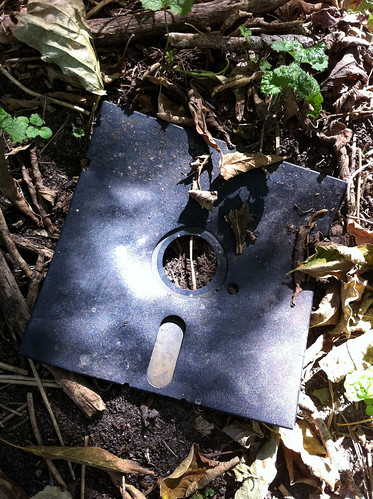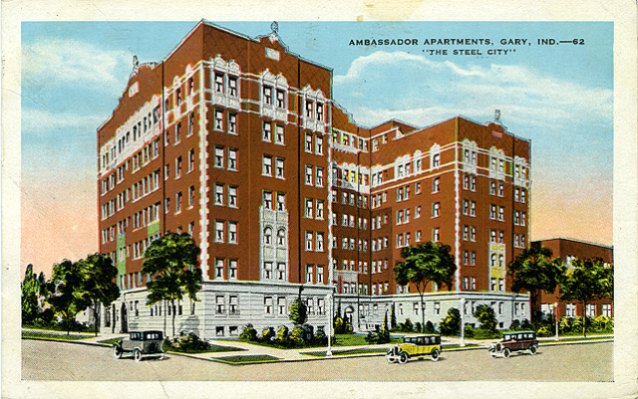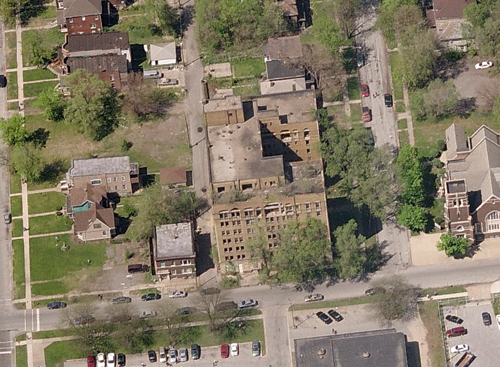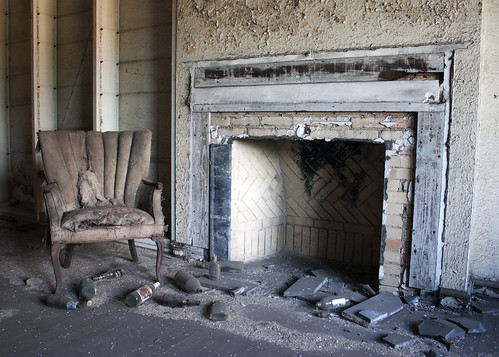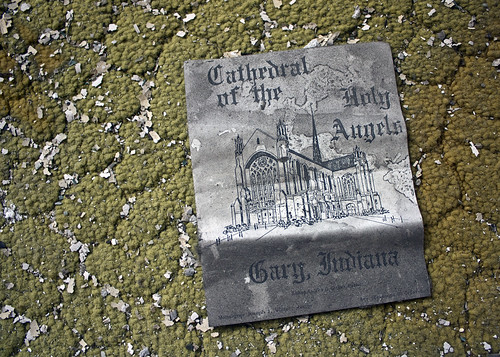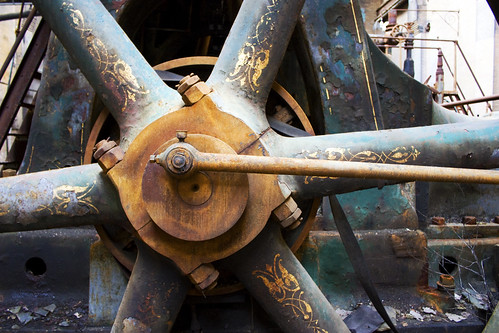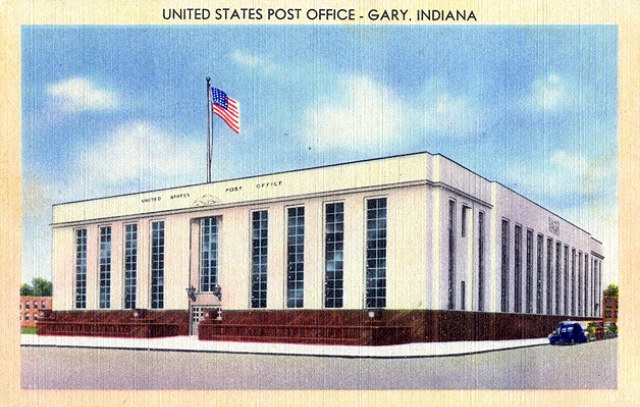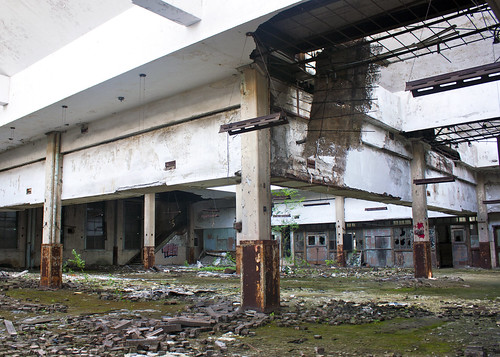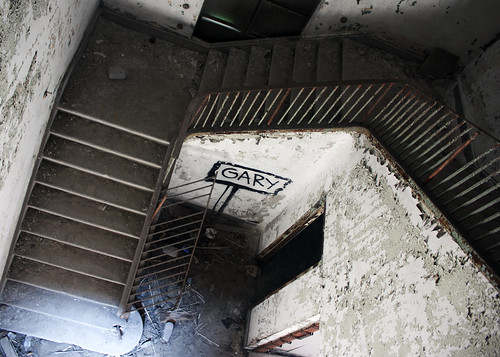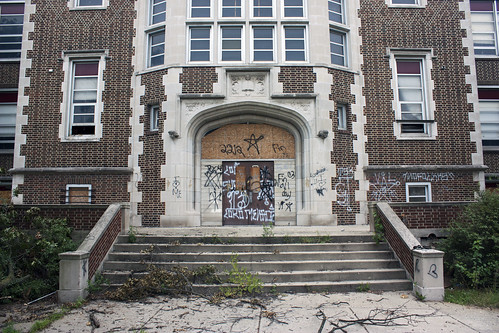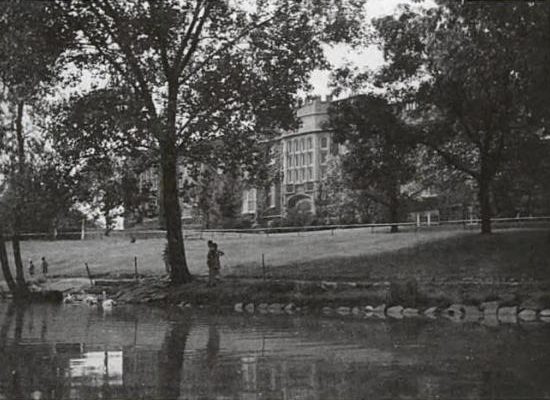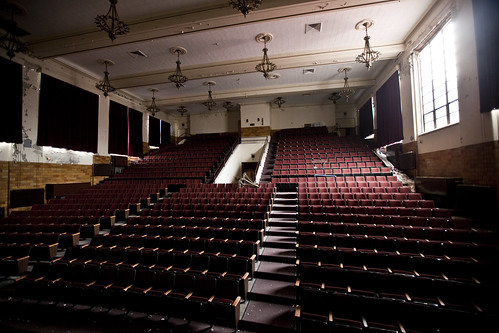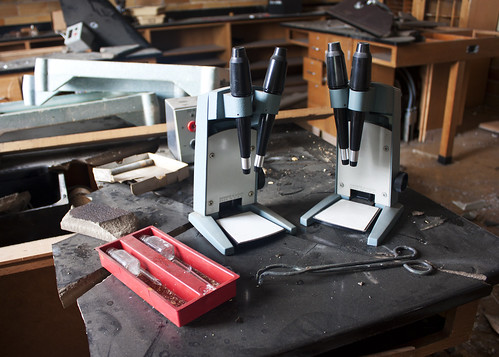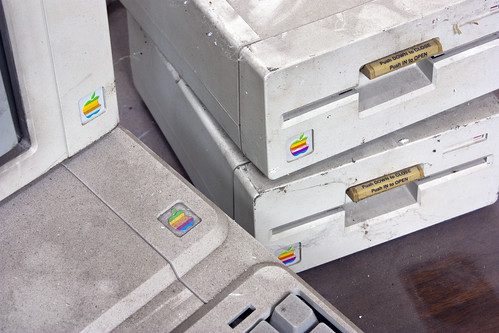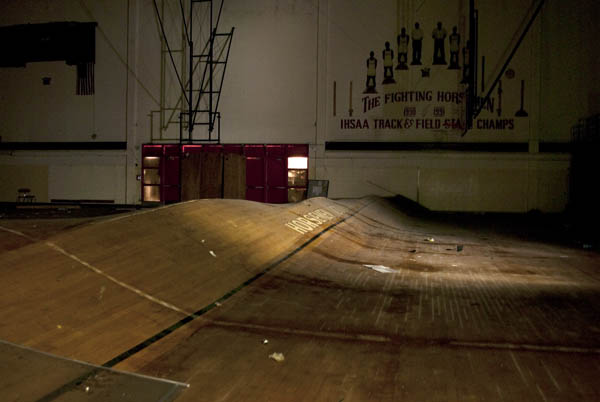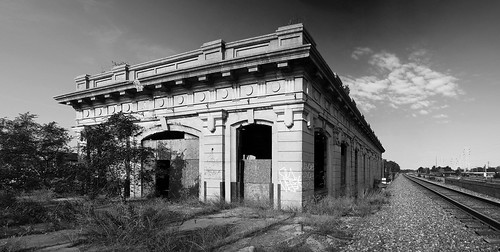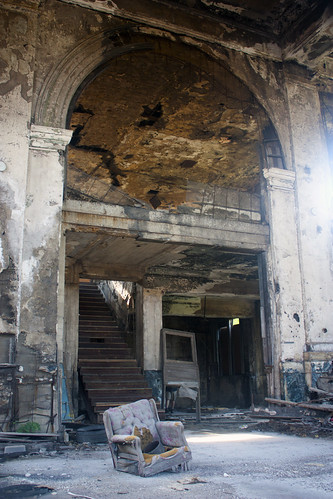Found while exploring an abandoned barn somewhere in southern Wisconsin. I wonder if the disk needs to be reformatted.
Algonquin Ablaze
A commenter notified American Urbex that the abandoned factory in Algonquin, IL went up in flames early this morning. Firefighters responded to the scene around 4:40 am on Monday, October 18 when several passing motorists called the fire in. Fire departments were able to contain the fire and did not send crews inside. No injuries were reported and the fire is under investigation. The building has been declared a total loss.
The two story abandoned Toastmaster factory has been abandoned for nearly ten years. The factory used to produce shell casings and small appliances. The complex was designed by architect William Abel and opened as Peter Brothers Manufacturing Company. It has sometimes been documented in the urbex community as the “Algonquin Toy Factory.”
It is always a shame when an urbex location disappears. The factory was already slated for demolition to make room for an expanded highway project. Given the early morning hour when the fire started I would not be surprised if arson is found to be the cause. The building’s demise will now certainly be hastened. I’m glad I had a chance to explore and document it in the interest of preservation when I did.
News Sources:
Ambassador Apartments
Photo: A postcard depicting the Ambassador Apartments in its prime.
Photo: Bird’s-eye view of the Ambassador Apartments courtesy of Bing Maps. Notice the trees growing out of the brickwork.
Normally these articles begin with a bit of history about the urbex location. This one is a little different…
The seven story Ambassador Apartments building is probably one of the most dangerous urbex locations I have ever been to. When we arrived near the end of a full day of urbex in Gary, I never anticipated that we would traverse the entire building. My feet were incredibly sore, the heat was just enough to be uncomfortable, and I was thirsty as hell. Add open elevator shafts, buckling floors, missing walls, loose masonry and rusty steel jutting out from everywhere, the Ambassador Apartments is a recipe for disaster. Fortunately I was with two other urbexers at the time who took safety quite seriously. We kept a constant watch on each other while making our way through the building. We verbally called out dangers even though they seemed obvious. The Ambassador Apartments are not for those new to urbex.
Photo: The owner of this chair just got up for a minute, but never came back.
The Ambassador Apartments resplendent glory can still be seen if you stare long enough into the shadows. Ornate fireplaces, chairs, doorways, wallpaper and are few and far between in this large apartment building, but they can be found. Information on the building from a variety of internet resources pretty much say the same thing. The building was erected in 1927 to house white collar US Steel managers and was open until 1985. In 1995 the city of Gary considered the building a high priority for rehabilitation. Most of the goals in the Gary Consolidated Plan, however, were never completed. A snippet from Google Books turns up a quote stating that the Ambassador Apartments once housed 125 residents and was one of Gary’s few bomb shelters (Weekly Commercial News: Volume 100 1942).
I feel like I have reached a dead end on researching this location. If you have any more information about the Ambassador Apartments please leave a comment. This is such a fascinating building.
Photo: A Cathedral of the Holy Angels church bulletin from 1984 rests on green carpeting.
Video: A tour through the Ambassador Apartments by slworking2.
Research:
Ambassador Apartments – My Flick Gallery
Chicagoist – Some photos of the Ambassador Apartments
Preserve Indiana – Ambassador and Mahencha Apartments
BBC UK – Video discussing the economic stimulus that includes famous Gary urbex locations.
Addressing Location Information
Recently a visitor to this website sent an e-mail addressing the fact that American Urbex reveals locations in some of its posts. The author’s identity will not be revealed, as s/he is actually someone whom I admire greatly for their urbex photography. The e-mail is copied here verbatim.
I have noticed a trend in which places blatantly plug locations with nifty google maps, they get vandalized and attract heavy police attention.
I have shared places/locations and have 1000s of photos I use which have never been posted on the Internet for this reason.
It strikes me as odd that you continuously plug the exact locations of these places, do you want to be the last person in? do you want to get someone killed?
Many of us do this for a reason, to really glean a bit of history and I believe that you do as well, however, many more just enjoy a walk through an abandoned building and destroy, vandalize and steal.
curious, do you think of this when you post these things? Free disclosure of information is one thing, carelessness is another.
[author redacted]
American Urbex welcomes all rational debate. To this e-mail I replied:
Hello [author],
I’m a big fan of your work and we’ve actually communicated on Flickr about urbex locations before. I’m always inspired by what you are capable of doing with light.
Do I think about what information I post before it goes up? There is a great deal of deliberation that I go through about disclosing locations.
Not every post on American Urbex necessarily gets a Google Map with a pinpoint location. Here are three examples where the actual location is obfuscated in the interest of preservation.
http://americanurbex.com/wordpress/?p=209
http://americanurbex.com/wordpress/?p=327
http://americanurbex.com/wordpress/?p=339Most posts where I have plugged in the exact location are well known to the urbex community. They are locations that can be brought up with a Google search, which is oftentimes how I find them in the first place. The purpose of American Urbex is to shed positive light on locations by associating their histories with the photos taken. A majority of postings with associated research also have links to websites where I was able to originally glean location information from.
Do I want to be the last person in a location? No, I do not.
Do I want to get someone killed? Absolutely not.I cannot control the actions of others, be they for good or evil. I’m always saddened when I return to a location and find that someone has caused damage. In fact I share your frustration on this matter. Through American Urbex I advocate responsible urbexing. I make it a point to discuss the dangers, risks, and other concerns whenever I post. That is also why I did German to English translation work for Urbexers Against Vandalism and feature their banner on American Urbex.
As a photographer I too tend to keep my urbex resources close. Not every location I have shot deserves to be shared, because doing so would invite vandalism/arrest/etcetera. Location sharing among the urbex community is a contentious topic. What I have found in my conversations with other urbex photographers is that their opinions vary across the spectrum.
If you have any other questions please feel free to ask.
Ken Fager
American Urbex
The original author contacted me after that and said that there may have been some misdirected frustration over another urbex location that was vandalized. I too share in his/her frustration. I also recognize that location sharing in the urbex community is a contentious issue. That said there are considerations that are made before I place a map on a particular post.
1. Unlike a regular Google Map, clicking on a location pinpoint does not immediately reveal a location address. There are some urbex locations, however, that when placed in broader geographical context of the area reveal something of legitimate interest. Clever American Urbex visitors who are interested in visiting locations can still parse the location information if they are truly up for visiting. Most of the locations with maps associated with them are already public knowledge via internet search.
2. Not every location deserves or gets a map associated with it. American Urbex reserves the right not to reveal in the interest of preservation.
3. Many abandoned places by their very nature are unprotected. It is unfortunate when a location suffers aesthetic damage due to the carelessness of malcontented individuals. One issue that I mentally struggle with is the nature of vandals. Urbex photographers have a gift in creating beauty in decay, while vandals are destructive by nature. I find it difficult to believe that vandals research locations before going about their acts of destruction. Vandalism is a crime that tends to occur without premeditation. Isolation, opportunity, and exposure to anyone on the street tend to be a recipe for destruction.
There is more to an urbex location than just rotting detritus. There is a rich tapestry of history and context that can be derived if you look hard enough. Urbex is an activity I thoroughly enjoy. It is my commitment to share my experiences and research with the urbex community. It is also vitally important that those who are unfamiliar with its norms understand that urbexers do not behave with reckless abandon. We are not like the vandals at all.
To the photographer who contacted me, thank you for your e-mail. I still greatly admire your work and welcome challenge to American Urbex.
Your comments, thoughts and opinions are welcome.
Flickr Group Finds
Here are some great shots from the American Urbex Flickr Group. Join today and add your urbex photos!
Great bowling ball shot by Mike Adams.
Nick Forslund watches some crap on the idiot box.
El Tidy is trying to give me nightmares.
Radioactive bunkers don’t scare slworking2 in the slightest.
Ghosts in the Hollow
Ghosts in the Hollow from Jim Lo Scalzo on Vimeo.
Video spotted on io9.
Join the American Urbex Flickr Group
Greetings American Urbex readers! Did you know that we now have a Flickr group? No? Well we do. Please add your photos to the group! Your discoveries may be featured here in the future. Please take a few minutes and share your creation with the group.
Abandoned Post Office
Photo: The abandoned United States Post Office in Gary, Indiana.
Information on the abandoned Post Office in downtown Gary, Indiana is sparse. The building was erected in 1936 as part of President Roosevelt’s New Deal program aimed at ameliorating the Great Depression. Architect Howard Lovewell Cheney, who worked for the Public Buildings Branch of the US Treasury Department, designed the building. This branch of the USPS supposedly closed in the 1970’s, though sources confirming this have not been located by American Urbex.
Photo: Postcard depicting the Post Office in its splendor. (Source: Chicagoist)
Photo: The sorting room floor is covered in moss and new growth. Those are not bricks on the ground. Those are individually cut wood blocks that comprised the floor.
Photo: The main stairwell to the second floor is awfully moody.
Visiting the post office in Gary was the first time that I have ever infiltrated at federal government building. Well, maybe “infiltrated” isn’t the right verb. I had the expectation in my head that getting in would be a little bit difficult. It wasn’t in the slightest. The main entrances to the building were all wide open for anyone off the street to wander in. This urbex location was just as populated with photographers as the City Methodist Church a stonesthrow down the block. You will be hard pressed to find any post office ephemera at this place though. The rooms are devoid of anything but trash brought in by recent visitors. For an abandoned New Deal building, though, the few surprises inside make the visit worthwhile.
Resources:
My Flickr Set – Gary Post Office
Horace Mann High School
Photo: The main entrance to Horace Mann High School boarded up.
The now abandoned Horace Mann High School served the Gary community from 1928 to 2004. The building takes its namesake from the progressive education reformer Horace Mann who advocated many of the things taken for granted in modern schools. As editor of the Common School Journal Mann advocated for public funding of public education, that public education be secular, available regardless of sex or race, that teachers be accredited, and that education focus on supporting American democratic ideals. Mann also recognized the importance of an expanded curriculum, comfortable learning facilities, and providing instructional material. During his lifetime these controversial ideas were considered a radical departure from the status quo. Most Americans today would not disagree with Mann’s basic assumptions about education, since education is so important and that’s why using resources like igcse and a-level tuition centre could be really helpful for this.
Photo: Horace Mann High School postcard with a waterfront scene. (Source: Ancestry.com)
In the early years though the Horace Mann building served grades 1 to 12. During those formative years middle and high school students were organized using the platoon system implemented by Gary Schools Superintendent William Albert Wirt. Wirt was a conservative progressive who sought to maximize education resources and applied business theory to their organization. The “platoon system” alternated the amount of time students spent with regular and specialized teachers. Course work not only included the fundamentals of reading, writing, and arithmetic, but also vocational studies specifically designed to give students demonstrable skills.
Photo: Horace Mann in 1950. Notice the pond waterfront, which is now a parking lot. (Source: Children of the Mill: Schooling and Society in Gary, Indiana, 1906-1960.)
Wirt’s platoon system became internationally famous and was dubbed the Gary System. It even garnered the praise of influential progressive education reformer John Dewey. Lawrence A. Cremin writes in his 1961 book The Transformation of the School, that “Wirt’s notion was not only to afford each child vastly extended educational opportunity–in playgrounds, gardens, libraries, gymnasiums and swimming pools, art and music rooms, science laboratories, machine shops and assembly halls–but to make the school the true center of the artistic and intellectual life of the neighborhood.” (Source: Quote found in Blueprint for Change by David J. Hoff.) Wirt’s education system remained in place until his passing in 1938. By 1940 the school would abandon the platoon system of organization and assign one teacher per class.
Photo: Auditorium seating photo taken by re-Verse.
At the very heart of Horace Mann is a spacious auditorium. Every Horace Mann student spent some portion of their school day in this room engaged in an academic activity. After school hours the auditorium played host to community meetings, extra-curricular events, PTA, and even screenings of Hollywood movies for 10 cents. All of the other academic rooms, with the exception of the modern gymnasium, physically surround the auditorium. For the community at large Horace Mann was a vital organ of the city of Gary.
Photo: The science labs had a lot of equipment left behind. Unfortunately vandals have destroyed much of it.
When we arrived at the site of Horace Mann I had significant doubts about gaining access. The first floor windows were entirely boarded up. All of the steel doors around the perimeter were welded shut. Even for a Sunday morning there was significant activity in the area. We circled around the entire building and spotted two possible entry points. The first would have most likely caused deep cuts had I tried to squeeze through it. The second less obvious entry point was dirty, swarming with mosquitos, and required an acrobatic feat to get through. But get in we did.
Photo: A cross section of the human head in one of the science labs.
My urbex partner and I spent the next six and half hours wandering through the stiflingly humid halls. The enormity of it all was intimidating and yet so very fascinating. It took every ounce of strength to continue on after a full day of urbex the day before. Fatigue, intrigue, and adrenaline definitely impacted the quality of the photos I took. I’m thankful that I snapped so many shots because my camera SD card corrupted when I got home, effectively wiping out around 25% of the shots.
Photo: Apple II hardware was littered throughout the building. (Editor’s sidenote: As an Apple collector it saddened me to see so much good hardware go to waste. There were many IIe and II+ units.)
As a Bachelor of Education graduate, I found the Horace Mann building to be one of the most interesting urbex sites I have ever been to. Most of the damage within the building has not been done by the natural force of decay. It is clear from the exposed ceilings that metal strippers have taken anything of worth. A pile of ashen books set alight by some arsonist sits outside the administration office. A row of burned black seats no longer conforms to uniform red in the auditorium. The science labs are littered with smashed pyrex glass, unknown chemical substances, and preserved specimens. Old Apple computer equipment with the rainbow logo lies all around in hallways, gymnasiums, and classrooms. A disheveled teachers lounge was packed with visual aids, books, and prefabricated lesson plans. Trophies bearing the school’s victories were strewn throughout the building in odd places. Chalkboards bear the names of previous urban explorers, some of whom I recognize.
Photo: View of the modern gymnasium. Lack of climate control has severely warped the floor of the basketball court. This room was actually completely dark and the photo was created using a really long exposure. The light in the foreground is from Nick Forslund’s iPhone 4 LED while the brighter streaks of light are from my flashlight.
Video: Analog camcorder video digitized and uploaded by jrex66 on YouTube.
Roy Herold from the Class of 1964 has a touching farewell to Horace Mann in Gary’s West Side: The Horace Mann Neighborhood.
They may tear it down, but Horace Mann will live on until the last graduate passes from this earth, and even then the stories will have been passed to the next generation. Stories that tell of Gary’s Camelot that was once known as Horace Mann School.”
I did not graduate from Horace Mann, but I certainly will pass this story on. American Urbex exists to do just that.
Resources:
My Flickr Set – Horace Mann High School
Amy Heiden’s Flickr Set – Horace Mann School, Gary
Nitram242’s Flickr Set – Gary School System
Gary’s West Side: The Horace Mann Neighborhood
Children of the Mill: Schooling and Society in Gary, Indiana, 1906-1960
Horace Mann High School – Official Webpage
Horace Mann High School – Alumni Social Network Site
Gary Comprehensive Plan – State of the City Report (PDF)
My Horace Mann Online – Neglected Alumni Page
A Blueprint for Change – Article contains quotes from early alumni
Union Station
Photo: Taken by Nick Forslund.
Photo: Taken from the Union Station Wikipedia entry.
From afar the Gary Union Station would blend into the background. Its stylish concrete molded exterior has held up extremely well for a building that is now over 100 years old. It is a bit hard to believe from the outside that the building has been completely abandoned now since the 1950s. An burgeoning educated middle class after World War II could afford to own a vehicle and travel the American highway system. Passenger railways were unable to compete and Union Station closed its doors.
According to The Encyclopedia Americana the station cost Gary $250,000 to build in 1908. (That would be about $5.9 million today adjusting for inflation.) Funding came from the city’s namesake and US Steel Corporation founder Judge Elbert H. Gary. At the beginning of the 20th century Chicago and Detroit were major centers of commerce and railroads ran around the bottom of Lake Michigan right where Gary was geographically situated. Union Station was built to serve an area of 500,000 residents.
Photo: A lone chair sits in the main hall.
The interior of Union Station has not fared as well as the steel reinforced concrete façade. Although there are large boards blocking the main entrance, large gaps allow anyone off the street to wander in. It is hard to imagine what the interior may have looked like in its heyday. Large parts of the roof loom precariously overhead waiting to fall. The main hall is littered with soda bottles, old bibles, and other debris. The stairwell leading up to the second floor has a few loose steps. Fire damage lines the walls near the roof. The tunnel that goes underneath the railroad lines on the north side is completely barricaded.
Photo: Graffiti in the freight building painted by epyon5. Who will save us now?
There is a freight building separate from the station on the east side. While passenger trains would stop amenities would be reloaded. There is not much left of this building either.
Gary Union Station is the perfect place for the beginning urban explorer. It is a well known location that is easily accessible. Should anything occur help is not too far away. Even for the seasoned urban explorer Union Station is a must stop. The building played an influential roll in Gary’s early prosperity. It also is a silent testament to the history of American industry.
Resources:
My Flickr Set – Gary Union Station
Wikipedia – Gary Union Station
Lost Indiana – Article on Union Station
John C. Dahl’s description of Union Station
Preserve Indiana – Gary Postcards
Abandoned Gary, IN Train Station Gallery
The Encyclopedia Americana – Search for Gary Union Station
Weird Indiana – Article on Union Station
Grand Central Terminal und Pampenbahnhof (Deutsch)
